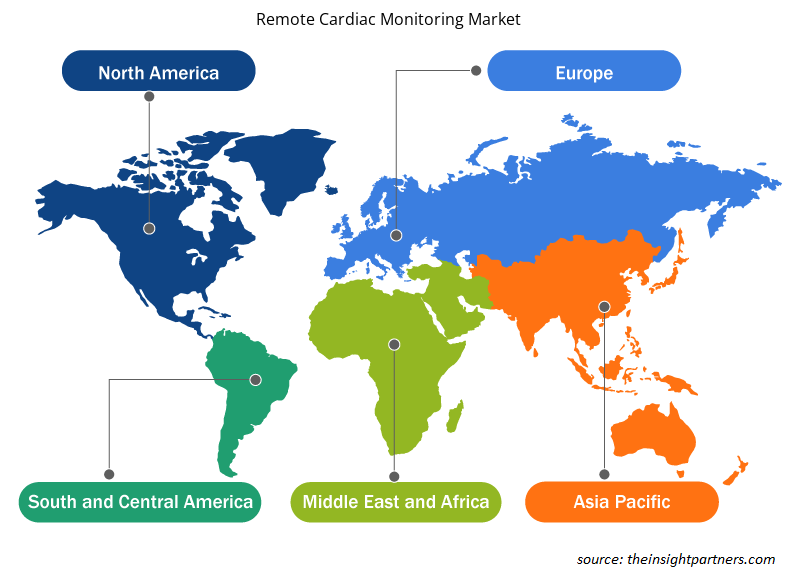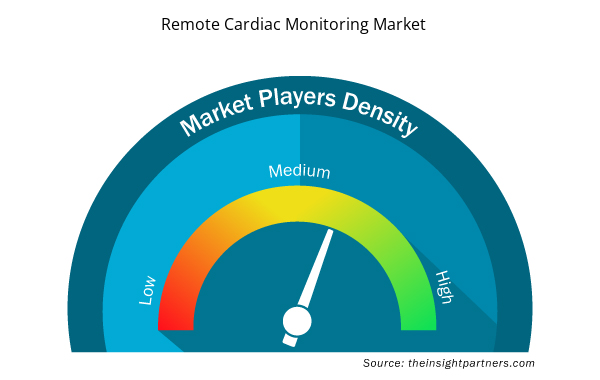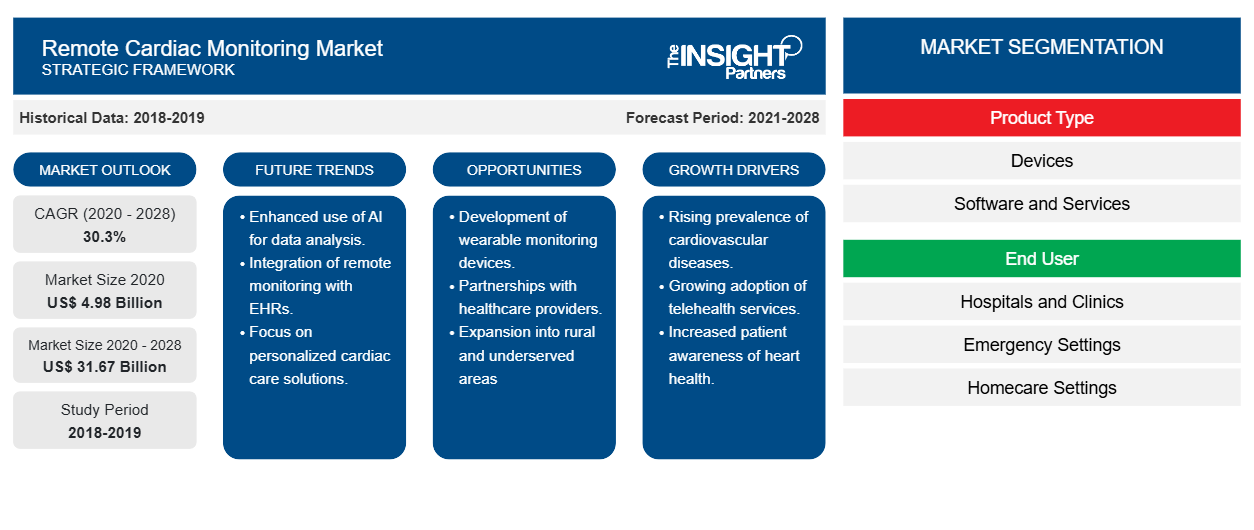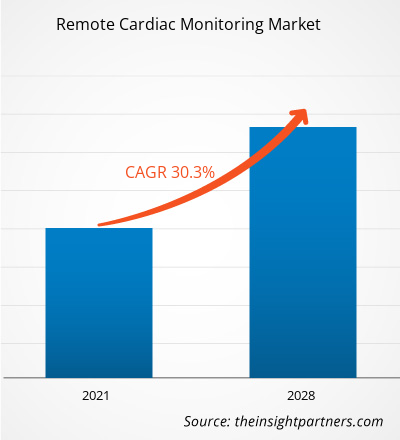원격 심장 모니터링 시장 규모는 2021년 49억 7,640만 달러에서 2028년 316억 7,169만 달러로 성장할 것으로 예상되며, 2021년에서 2028년까지 연평균 성장률 30.3%로 성장할 것으로 추산됩니다.
원격 심장 모니터링 장치는 병원 밖에서도 심장의 전기적 활동을 지속적으로 모니터링할 수 있게 해줍니다. 또한 부정맥이 의심되거나 부정맥이 발생할 위험이 있는 환자의 집에서 심전도(ECG) 모니터링도 가능합니다. 환자가 일상 생활에 몰두해 있을 때도 모니터링을 수행할 수 있습니다. 따라서 원격 심장 장치 모니터링의 가장 중요한 이점 중 하나는 정기적인 의사 방문의 필요성을 줄여준다는 것입니다. 심장 박동 조절기 및 이식형 심장 제세동기와 같은 장치는 최소 침습적 시술을 통해 환자의 심장에 이식됩니다. 장치와 동기화되어 작동하는 송신기가 데이터 전송을 담당합니다. 심혈관 질환(CVD) 발생률 증가와 원격 의료 접근 방식의 지속적인 발전과 같은 요인이 원격 심장 모니터링 시장 의 성장을 촉진합니다 . 그러나 데이터 개인 정보 보호에 대한 우려가 시장 성장을 방해합니다.
귀하의 요구 사항에 맞게 이 보고서를 사용자 정의하세요
이 보고서의 일부 또는 국가 수준 분석, Excel 데이터 팩을 포함하여 모든 보고서에 대한 사용자 정의를 무료로 받을 수 있으며 신생 기업 및 대학을 위한 훌륭한 혜택과 할인 혜택을 이용할 수 있습니다.
- 이 보고서의 주요 시장 동향을 알아보세요.이 무료 샘플에는 시장 동향부터 추정 및 예측까지 다양한 데이터 분석이 포함됩니다.
시장 통찰력
심혈관 질환 발생률 증가
원격 환자 모니터링(RPM)을 통해 환자는 건강 관리에 더 많이 참여하여 건강을 더 잘 관리할 수 있습니다.미국 심장 협회는 증거 기반 원격 환자 모니터링 기술의 설계 및 사용에 대한 인센티브를 제공하는 이니셔티브를 지원합니다.세계보건기구(WHO)에 따르면 심혈관 질환(CVD)은 전 세계적으로 사망의 주요 원인 중 하나이며 매년 약 3천만 명이 뇌졸중을 겪습니다.미국 심장 협회에 따르면 미국 성인의 거의 절반이 CVD 유형을 앓고 있습니다.또한 2035년까지 미국 인구의 45.1%인 1억 3천만 명 이상이 CVD 유형을 앓을 것으로 예상됩니다.유럽 심장학회의 보고서에 따르면 CVD는 유럽에서 390만 명, 유럽 연합(EU)에서 180만 명 이상의 사망을 초래합니다.또한 유럽 전체 사망자의 45%, EU 전체 사망자의 37%를 차지합니다. 아시아 태평양 국가에서 CVD로 인한 사망률은 태국, 필리핀, 인도네시아와 같은 국가에서는 20% 미만에서 중국, 홍콩, 일본, 한국, 말레이시아와 같은 도시에서는 20~30%에 이릅니다. 또한 뉴질랜드, 호주, 싱가포르 등은 30~35%로 비교적 높은 비율을 보입니다.
고혈압은 CVD의 중요한 위험 요인입니다. 미국 성인의 연령에 따른 고혈압 유병률은 약 35%로, 약 8,500만 명의 인구와 같습니다. 2035년까지 이 나라의 성인의 약 42%, 즉 추가로 2,700만 명이 이 질환을 앓게 될 것입니다. 경제에 대한 고혈압의 비용 부담도 증가하고 있으며, 비용은 2015년의 약 700억 달러에서 2035년까지 약 1,500억 달러로 급증할 가능성이 높습니다. 원격 환자 모니터링은 고혈압 관리를 개선하고 급성 고혈압 관련 사건으로 인한 장기 또는 빈번한 입원으로 인한 경제적 부담을 줄이는 데 중요한 수단이 될 수 있습니다. 연구에 따르면 (원격 환자 모니터링) RPM은 일반적인 치료 및 자가 모니터링에 비해 수축기 혈압(SBP)과 이완기 혈압(DBP)을 상당히 낮출 수 있습니다. 몇몇 무작위화되지 않은 시험에 따르면 RPM 장치는 정확하고 조기에 감지할 수 있게 하고 모든 원인 사망률과 입원을 줄임으로써 결과를 개선할 수 있습니다. 최근 임상 지침은 뇌졸중과 비뇌졸중 환자 모두에서 심방세동(AF) 감지를 위해 RPM을 사용할 것을 강력히 권장합니다.
제품 유형 기반 통찰력
제품 유형에 따라 원격 심장 모니터링 시장은 장치, 소프트웨어 및 서비스로 세분화됩니다. 장치 세그먼트는 2021년에 더 큰 시장 점유율을 차지했으며 예측 기간 동안 더 높은 CAGR을 기록할 것으로 예상됩니다.
최종 사용자 기반 통찰력
최종 사용자를 기준으로 원격 심장 모니터링 시장은 병원 및 진료소, 응급 상황, 홈 케어 상황 등으로 세분화됩니다. 병원 및 진료소 부문은 2021년에 가장 큰 시장 점유율을 차지할 것으로 예상되고, 응급 상황 부문 시장은 예측 기간 동안 31.60%의 CAGR로 성장할 것으로 예상됩니다.
원격 심장 모니터링 시장에서 활동하는 다양한 회사는 제품 출시, 합병 및 인수, 협업, 제품 혁신, 제품 포트폴리오 확장과 같은 전략을 채택하여 전 세계적으로 입지를 확대하고, 브랜드 이름을 유지하며, 최종 사용자의 증가하는 수요를 충족하고 있습니다.
원격 심장 모니터링 시장 지역 통찰력
Insight Partners의 분석가들은 예측 기간 동안 원격 심장 모니터링 시장에 영향을 미치는 지역적 추세와 요인을 철저히 설명했습니다. 이 섹션에서는 북미, 유럽, 아시아 태평양, 중동 및 아프리카, 남미 및 중미의 원격 심장 모니터링 시장 세그먼트와 지리에 대해서도 설명합니다.

- 원격 심장 모니터링 시장을 위한 지역별 특정 데이터 얻기
원격 심장 모니터링 시장 보고서 범위
| 보고서 속성 | 세부 |
|---|---|
| 2020년 시장 규모 | 49억 8천만 달러 |
| 2028년까지 시장 규모 | 316억 7천만 달러 |
| 글로벌 CAGR (2020-2028) | 30.3% |
| 역사적 데이터 | 2018-2019 |
| 예측 기간 | 2021-2028 |
| 다루는 세그먼트 | 제품 유형별
|
| 포함된 지역 및 국가 | 북아메리카
|
| 시장 선도 기업 및 주요 회사 프로필 |
|
시장 참여자 밀도: 비즈니스 역학에 미치는 영향 이해
원격 심장 모니터링 시장 시장은 소비자 선호도의 변화, 기술 발전, 제품의 이점에 대한 인식 증가와 같은 요인으로 인해 최종 사용자 수요가 증가함에 따라 빠르게 성장하고 있습니다. 수요가 증가함에 따라 기업은 제품을 확장하고, 소비자의 요구를 충족하기 위해 혁신하고, 새로운 트렌드를 활용하여 시장 성장을 더욱 촉진하고 있습니다.
시장 참여자 밀도는 특정 시장이나 산업 내에서 운영되는 회사나 기업의 분포를 말합니다. 주어진 시장 공간에 얼마나 많은 경쟁자(시장 참여자)가 존재하는지 그 규모나 전체 시장 가치에 비해 나타냅니다.
원격 심장 모니터링 시장에서 운영되는 주요 회사는 다음과 같습니다.
- OSI 시스템 주식회사
- GE 헬스케어
- 바이오트로닉 세
- 니혼코덴 주식회사
- 애벗 연구소
면책 조항 : 위에 나열된 회사는 어떤 특별한 순서에 따라 순위가 매겨지지 않았습니다.

- 원격 심장 모니터링 시장 주요 주요 업체 개요를 알아보세요
원격 심장 모니터링 시장 – 제품 유형별
- 장치
- 소프트웨어
- 서비스
원격 심장 모니터링 시장 – 최종 사용자별
- 병원 및 진료소
- 비상 설정
- 홈케어 설정
- 기타
원격 심장 모니터링 시장 – 지리별
- 북아메리카
- 우리를
- 캐나다
- 멕시코
- 유럽
- 프랑스
- 독일
- 이탈리아
- 영국
- 스페인
- 유럽의 나머지 지역
- 아시아 태평양(APAC)
- 중국
- 인도
- 대한민국
- 일본
- 호주
- 아시아 태평양의 나머지 지역
- 중동 및 아프리카(MEA)
- 남아프리카 공화국
- 사우디 아라비아
- 아랍에미리트
- 중동 및 아프리카의 나머지 지역
- 남미 및 중미(SCAM)
- 브라질
- 아르헨티나
- 남미와 중미의 나머지 지역
회사 프로필
- OSI 시스템 주식회사
- GE 헬스케어
- 바이오트로닉 세
- 니혼코덴 주식회사
- 애벗 연구소
- 보스턴 사이언티픽 코퍼레이션
- 코닌클리크 필립스 NV
- 허니웰 인터내셔널 주식회사
- AMC 건강
- 역사적 분석(2년), 기준 연도, CAGR을 포함한 예측(7년)
- PEST 및 SWOT 분석
- 시장 규모 가치/양 - 글로벌, 지역, 국가
- 산업 및 경쟁 환경
- Excel 데이터 세트



Report Coverage
Revenue forecast, Company Analysis, Industry landscape, Growth factors, and Trends

Segment Covered
This text is related
to segments covered.

Regional Scope
North America, Europe, Asia Pacific, Middle East & Africa, South & Central America

Country Scope
This text is related
to country scope.
자주 묻는 질문
Global remote cardiac monitoring market is segmented by region into North America, Europe, Asia Pacific, Middle East & Africa and South & Central America. In North America, the U.S. is the largest market for remote cardiac monitoring. The US is estimated to hold the largest share in the remote cardiac monitoring market during the forecast period. The growth of the market can be because of the rising investments in cardiology informatics, connected devices, and mobile solutions for advanced cardiac care, increasing product launches, and R&D activities to develop advanced remote cardiac monitoring devices. In addition, technologically advanced products are likely to stimulate the growth of remote cardiac monitoring market in North America. On the other hand, growing emphasis on cost optimization, focus on streamlining of clinical processes, increasing number of clinical trials, rise in the government initiatives, growing number of research and development activities, and rising number of product launches and approvals in the Asia Pacific is expected to account for the fastest growth of the region during the coming years.
The remote cardiac monitoring market majorly consists of the players such OSI Systems, Inc., GE Healthcare, Biotronik Se, Nihon Kohden Corporation, Abbott Laboratories, Boston Scientific Corporation, Koninklijke Philips N.V., Honeywell International, Inc. and AMC Health among others.
The hospitals and clinics segment dominated the global remote cardiac monitoring market and accounted for the largest revenue share of 37.60% in 2021.
The device segment dominated the global remote cardiac monitoring market and held the largest revenue share of 58.53% in 2021.
Remote cardiac monitoring is the constant monitoring of electrical activities of the heart, which practices place outside hospitals. The monitoring can also be performed while the patient is doing the day-to-day activities. Devices like pacemakers and implantable cardioverter-defibrillator are placed with the patient through minimally invasive procedures. The transmission of data takes place within a transmitter that works in sync with the device. Remote cardiac monitoring technologies allow home electrocardiographic (ECG) monitoring of patients with suspected cardiac arrhythmias or at risk for developing arrhythmias. One of the most important benefits of remote cardiac device monitoring is that it cuts down on routine doctor visits. Without remote monitoring, patients visited the doctor every three to six months (depending on device type) for a data download. With remote monitoring, the number of visits have dropped to one to two per year. Remote cardiac device monitoring is a fantastic way to follow patients and it has always been important, but it’s especially important in this era of COVID-19.
Key factors that are driving the growth of this market are increase in incidence of cardiovascular diseases, continuous developments in telemedicine approach, and rising investment in research and development are expected to boost the market growth for the remote cardiac monitoring over the years.
Trends and growth analysis reports related to Life Sciences : READ MORE..
The List of Companies - Remote Cardiac Monitoring Market
- OSI Systems, Inc.
- GE Healthcare
- Biotronik Se
- Nihon Kohden Corporation
- Abbott Laboratories
- Boston Scientific Corporation
- Koninklijke Philips N.V.
- Honeywell International, Inc.
- AMC Health
The Insight Partners performs research in 4 major stages: Data Collection & Secondary Research, Primary Research, Data Analysis and Data Triangulation & Final Review.
- Data Collection and Secondary Research:
As a market research and consulting firm operating from a decade, we have published and advised several client across the globe. First step for any study will start with an assessment of currently available data and insights from existing reports. Further, historical and current market information is collected from Investor Presentations, Annual Reports, SEC Filings, etc., and other information related to company’s performance and market positioning are gathered from Paid Databases (Factiva, Hoovers, and Reuters) and various other publications available in public domain.
Several associations trade associates, technical forums, institutes, societies and organization are accessed to gain technical as well as market related insights through their publications such as research papers, blogs and press releases related to the studies are referred to get cues about the market. Further, white papers, journals, magazines, and other news articles published in last 3 years are scrutinized and analyzed to understand the current market trends.
- Primary Research:
The primarily interview analysis comprise of data obtained from industry participants interview and answers to survey questions gathered by in-house primary team.
For primary research, interviews are conducted with industry experts/CEOs/Marketing Managers/VPs/Subject Matter Experts from both demand and supply side to get a 360-degree view of the market. The primary team conducts several interviews based on the complexity of the markets to understand the various market trends and dynamics which makes research more credible and precise.
A typical research interview fulfils the following functions:
- Provides first-hand information on the market size, market trends, growth trends, competitive landscape, and outlook
- Validates and strengthens in-house secondary research findings
- Develops the analysis team’s expertise and market understanding
Primary research involves email interactions and telephone interviews for each market, category, segment, and sub-segment across geographies. The participants who typically take part in such a process include, but are not limited to:
- Industry participants: VPs, business development managers, market intelligence managers and national sales managers
- Outside experts: Valuation experts, research analysts and key opinion leaders specializing in the electronics and semiconductor industry.
Below is the breakup of our primary respondents by company, designation, and region:

Once we receive the confirmation from primary research sources or primary respondents, we finalize the base year market estimation and forecast the data as per the macroeconomic and microeconomic factors assessed during data collection.
- Data Analysis:
Once data is validated through both secondary as well as primary respondents, we finalize the market estimations by hypothesis formulation and factor analysis at regional and country level.
- Macro-Economic Factor Analysis:
We analyse macroeconomic indicators such the gross domestic product (GDP), increase in the demand for goods and services across industries, technological advancement, regional economic growth, governmental policies, the influence of COVID-19, PEST analysis, and other aspects. This analysis aids in setting benchmarks for various nations/regions and approximating market splits. Additionally, the general trend of the aforementioned components aid in determining the market's development possibilities.
- Country Level Data:
Various factors that are especially aligned to the country are taken into account to determine the market size for a certain area and country, including the presence of vendors, such as headquarters and offices, the country's GDP, demand patterns, and industry growth. To comprehend the market dynamics for the nation, a number of growth variables, inhibitors, application areas, and current market trends are researched. The aforementioned elements aid in determining the country's overall market's growth potential.
- Company Profile:
The “Table of Contents” is formulated by listing and analyzing more than 25 - 30 companies operating in the market ecosystem across geographies. However, we profile only 10 companies as a standard practice in our syndicate reports. These 10 companies comprise leading, emerging, and regional players. Nonetheless, our analysis is not restricted to the 10 listed companies, we also analyze other companies present in the market to develop a holistic view and understand the prevailing trends. The “Company Profiles” section in the report covers key facts, business description, products & services, financial information, SWOT analysis, and key developments. The financial information presented is extracted from the annual reports and official documents of the publicly listed companies. Upon collecting the information for the sections of respective companies, we verify them via various primary sources and then compile the data in respective company profiles. The company level information helps us in deriving the base number as well as in forecasting the market size.
- Developing Base Number:
Aggregation of sales statistics (2020-2022) and macro-economic factor, and other secondary and primary research insights are utilized to arrive at base number and related market shares for 2022. The data gaps are identified in this step and relevant market data is analyzed, collected from paid primary interviews or databases. On finalizing the base year market size, forecasts are developed on the basis of macro-economic, industry and market growth factors and company level analysis.
- Data Triangulation and Final Review:
The market findings and base year market size calculations are validated from supply as well as demand side. Demand side validations are based on macro-economic factor analysis and benchmarks for respective regions and countries. In case of supply side validations, revenues of major companies are estimated (in case not available) based on industry benchmark, approximate number of employees, product portfolio, and primary interviews revenues are gathered. Further revenue from target product/service segment is assessed to avoid overshooting of market statistics. In case of heavy deviations between supply and demand side values, all thes steps are repeated to achieve synchronization.
We follow an iterative model, wherein we share our research findings with Subject Matter Experts (SME’s) and Key Opinion Leaders (KOLs) until consensus view of the market is not formulated – this model negates any drastic deviation in the opinions of experts. Only validated and universally acceptable research findings are quoted in our reports.
We have important check points that we use to validate our research findings – which we call – data triangulation, where we validate the information, we generate from secondary sources with primary interviews and then we re-validate with our internal data bases and Subject matter experts. This comprehensive model enables us to deliver high quality, reliable data in shortest possible time.


 이 보고서에 대한 무료 샘플을 받으세요
이 보고서에 대한 무료 샘플을 받으세요